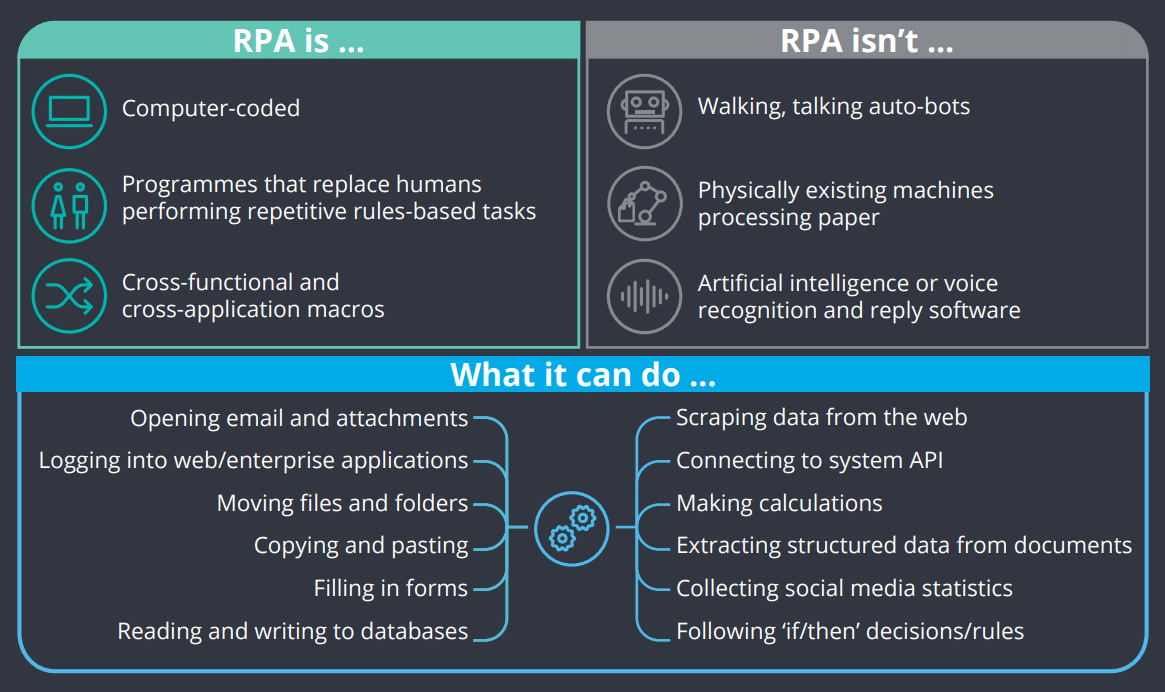
Automation Definition
The application of this study to the design of computer-driven and other automated equipment. The application of this study to the design of artificial limbs, organs, and other prosthetic devices. — bionic, adj.
English[edit]
Etymology[edit]
automatic + -ion or automaton + -ion; coined by a Ford Executive Vice President, Delmar S. Harder, in the 1940s.
Noun[edit]
automation (countable and uncountable, pluralautomations)
- The act or process of converting the controlling of a machine or device to a more automatic system, such as computer or electronic controls.
- 2012 October 23, David Leonhardt, '[1],' New York Times(retrieved 24 October 2012):
- The presidential campaign has been more focused on Bain Capital and an “apology tour” than on the challenges created by globalization and automation.
- 2012 October 23, David Leonhardt, '[1],' New York Times(retrieved 24 October 2012):
Synonyms[edit]
- automatization/automatisation
Related terms[edit]
- automatize/automatise
Translations[edit]
|
|
References[edit]
- automation at OneLook Dictionary Search
- “automation” in Douglas Harper, Online Etymology Dictionary, 2001–2020.
French[edit]
Pronunciation[edit]
- IPA(key): /o.tɔ.ma.sjɔ̃/, /ɔ.tɔ.ma.sjɔ̃/
Audio (Paris) Audio
Noun[edit]
automationf (pluralautomations)
Synonyms[edit]
Swedish[edit]
Noun[edit]
automationc
Declension[edit]
| Declension of automation | ||||
|---|---|---|---|---|
| Uncountable | ||||
| Indefinite | Definite | |||
| Nominative | automation | automationen | — | — |
| Genitive | automations | automationens | — | — |
Synonyms[edit]
| Part of a series on |
| Automation |
|---|
| Trade shows |
| Awards |
| Robots |
Block strike online. Industrial robot |
| General purpose |
Home automation |
| Specific purpose |
Automated attendant |
| Social movements |
In music recording, automation allows the console to remember the audio engineer's adjustment of faders during the post-production editing process. A timecode is necessary for synchronization of automation. Modern digital audio consoles or mixers use comprehensive mix automation. The need for mix automation originates from the 1970s and the changeover from studios mostly using eight-track tape machines to multiple, synchronized 24-track recorders. Mixing could be laborious and require up to four people, and the results could be almost impossible to reproduce. Manufacturers such as Solid State Logic and AMS Neve developed systems which enabled one engineer to oversee every detail of a complex mix, although the computers required to power these desks remained a rarity into the late 1970s.[1]
According to record producer Roy Thomas Baker, Queen's 1975 single 'Bohemian Rhapsody' was one of the first mixes to be done with automation.[2]
Types[edit]
- Voltage Controlled Automation
- fader levels are regulated by voltage-controlled amplifiers (VCA). VCAs control the audio level and not the actual fader.
- Moving Fader Automation
- a motor is attached to the fader, which then can be controlled by the console, digital audio workstation (DAW), or user.
- Software Controlled Automation
- the software can be internal to the console, or external as part of a DAW. The virtual fader can be adjusted in the software by the user.
- MIDI Automation
- the communications protocol MIDI can be used to send messages to the console to control automation.
Modes[edit]
- Auto Write
- used the first time automation is created or when writing over existing automation
- Auto Touch
- writes automation data only while a fader is touched/faders return to any previously automated position after release
- Auto Latch
- starts writing automation data when a fader is touched/stays in position after release
- Auto Read
- digital Audio Workstation performs the written automation
- Auto Off
- automation is temporarily disabled

All of these include the mute button. If mute is pressed during writing of automation, the audio track will be muted during playback of that automation.Depending on software, other parameters such as panning, sends, and plug-in controls can be automated as well. In some cases, automation can be written using a digital potentiometer instead of a fader.
See also[edit]
References[edit]
- ^Inglis, Sam. 'Creative Mix Automation In Your DAW'. Sound on Sound. Retrieved 31 August 2019.
- ^Clark, Rick (1 April 1999). 'Roy Thomas Baker: TAKING CHANCES AND MAKING HITS'. Mix. Retrieved 28 August 2019.
- Stanley R. Alten. Audio in Media, sixth edition. Wadsworth, 2002.
- David Miles Huber and Robert Runstein. Modern Recording Techniques, sixth edition. Oxford: Focal Press, 2005.